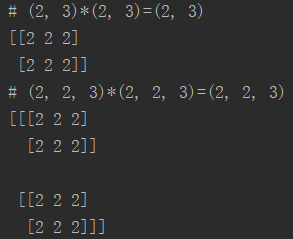Tensorflow矩陣運算(矩陣相乘,點乘,行/列累加)
阿新 • • 發佈:2018-12-08
Tensorflow二維、三維、四維矩陣運算(矩陣相乘,點乘,行/列累加)
1. 矩陣相乘
根據矩陣相乘的匹配原則,左乘矩陣的列數要等於右乘矩陣的行數。
在多維(三維、四維)矩陣的相乘中,需要最後兩維滿足匹配原則。
可以將多維矩陣理解成:(矩陣排列,矩陣),即後兩維為矩陣,前面的維度為矩陣的排列。
比如對於(2,2,4)來說,視為2個(2,4)矩陣。
對於(2,2,2,4)來說,視為2*2個(2,4)矩陣。
import tensorflow as tf a_2d = tf.constant([1]*6, shape=[2, 3]) b_2d = tf.constant([2]*12, shape=[3, 4]) c_2d = tf.matmul(a_2d, b_2d) a_3d = tf.constant([1]*12, shape=[2, 2, 3]) b_3d = tf.constant([2]*24, shape=[2, 3, 4]) c_3d = tf.matmul(a_3d, b_3d) a_4d = tf.constant([1]*24, shape=[2, 2, 2, 3]) b_4d = tf.constant([2]*48, shape=[2, 2, 3, 4]) c_4d = tf.matmul(a_4d, b_4d) with tf.Session() as sess: tf.global_variables_initializer().run() print("# {}*{}={} \n{}". format(a_2d.eval().shape, b_2d.eval().shape, c_2d.eval().shape, c_2d.eval())) print("# {}*{}={} \n{}". format(a_3d.eval().shape, b_3d.eval().shape, c_3d.eval().shape, c_3d.eval())) print("# {}*{}={} \n{}". format(a_4d.eval().shape, b_4d.eval().shape, c_4d.eval().shape, c_4d.eval()))


2. 點乘
點乘指的是shape相同的兩個矩陣,對應位置元素相乘,得到一個新的shape相同的矩陣。
a_2d = tf.constant([1]*6, shape=[2, 3]) b_2d = tf.constant([2]*6, shape=[2, 3]) c_2d = tf.multiply(a_2d, b_2d) a_3d = tf.constant([1]*12, shape=[2, 2, 3]) b_3d = tf.constant([2]*12, shape=[2, 2, 3]) c_3d = tf.multiply(a_3d, b_3d) a_4d = tf.constant([1]*24, shape=[2, 2, 2, 3]) b_4d = tf.constant([2]*24, shape=[2, 2, 2, 3]) c_4d = tf.multiply(a_4d, b_4d) with tf.Session() as sess: tf.global_variables_initializer().run() print("# {}*{}={} \n{}". format(a_2d.eval().shape, b_2d.eval().shape, c_2d.eval().shape, c_2d.eval())) print("# {}*{}={} \n{}". format(a_3d.eval().shape, b_3d.eval().shape, c_3d.eval().shape, c_3d.eval())) print("# {}*{}={} \n{}". format(a_4d.eval().shape, b_4d.eval().shape, c_4d.eval().shape, c_4d.eval()))


另外,點乘的其中一方可以是一個常數,也可以是一個和矩陣行向量等長(即列數)的向量。
即或
因為在點乘過程中,會自動將常數或者向量進行擴維。
a_2d = tf.constant([1]*6, shape=[2, 3]) k = tf.constant(2) l = tf.constant([2, 3, 4]) b_2d_1 = tf.multiply(k, a_2d) # tf.multiply(a_2d, k) is also ok b_2d_2 = tf.multiply(l, a_2d) # tf.multiply(a_2d, l) is also ok a_3d = tf.constant([1]*12, shape=[2, 2, 3]) b_3d_1 = tf.multiply(k, a_3d) # tf.multiply(a_3d, k) is also ok b_3d_2 = tf.multiply(l, a_3d) # tf.multiply(a_3d, l) is also ok a_4d = tf.constant([1]*24, shape=[2, 2, 2, 3]) b_4d_1 = tf.multiply(k, a_4d) # tf.multiply(a_4d, k) is also ok b_4d_2 = tf.multiply(l, a_4d) # tf.multiply(a_4d, l) is also ok with tf.Session() as sess: tf.global_variables_initializer().run() print("# {}*{}={} \n{}". format(k.eval().shape, a_2d.eval().shape, b_2d_1.eval().shape, b_2d_1.eval())) print("# {}*{}={} \n{}". format(l.eval().shape, a_2d.eval().shape, b_2d_2.eval().shape, b_2d_2.eval())) print("# {}*{}={} \n{}". format(k.eval().shape, a_3d.eval().shape, b_3d_1.eval().shape, b_3d_1.eval())) print("# {}*{}={} \n{}". format(l.eval().shape, a_3d.eval().shape, b_3d_2.eval().shape, b_3d_2.eval())) print("# {}*{}={} \n{}". format(k.eval().shape, a_4d.eval().shape, b_4d_1.eval().shape, b_4d_1.eval())) print("# {}*{}={} \n{}". format(l.eval().shape, a_4d.eval().shape, b_4d_2.eval().shape, b_4d_2.eval()))



4. 行/列累加
a_2d = tf.constant([1]*6, shape=[2, 3])
d_2d_1 = tf.reduce_sum(a_2d, axis=0)
d_2d_2 = tf.reduce_sum(a_2d, axis=1)
a_3d = tf.constant([1]*12, shape=[2, 2, 3])
d_3d_1 = tf.reduce_sum(a_3d, axis=1)
d_3d_2 = tf.reduce_sum(a_3d, axis=2)
a_4d = tf.constant([1]*24, shape=[2, 2, 2, 3])
d_4d_1 = tf.reduce_sum(a_4d, axis=2)
d_4d_2 = tf.reduce_sum(a_4d, axis=3)
with tf.Session() as sess:
tf.global_variables_initializer().run()
print("# a_2d 行累加得到shape:{}\n{}".format(d_2d_1.eval().shape, d_2d_1.eval()))
print("# a_2d 列累加得到shape:{}\n{}".format(d_2d_2.eval().shape, d_2d_2.eval()))
print("# a_3d 行累加得到shape:{}\n{}".format(d_3d_1.eval().shape, d_3d_1.eval()))
print("# a_3d 列累加得到shape:{}\n{}".format(d_3d_2.eval().shape, d_3d_2.eval()))
print("# a_4d 行累加得到shape:{}\n{}".format(d_4d_1.eval().shape, d_4d_1.eval()))
print("# a_4d 列累加得到shape:{}\n{}".format(d_4d_2.eval().shape, d_4d_2.eval()))

